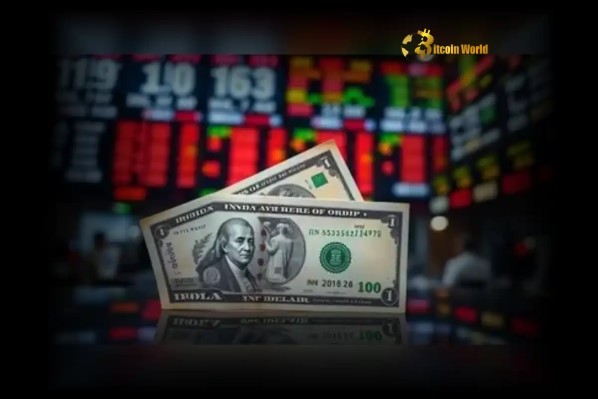BitcoinWorld

US Dollar’s Pivotal Week: Unveiling Central Bank Decisions and Market Impact
In the dynamic world of finance, major macroeconomic events often send ripples far beyond traditional markets, even touching the volatile realm of cryptocurrencies. This week stands as a pivotal moment, with the spotlight firmly on the US Dollar as key central bank meetings approach. Traders, investors, and even crypto enthusiasts are keenly watching how decisions from the Federal Open Market Committee (FOMC) and the Bank of England (BoE) will shape global liquidity, risk sentiment, and ultimately, asset valuations. Understanding these shifts is crucial for anyone navigating the complex interplay between traditional finance and digital assets.
Understanding the US Dollar‘s Current Stance
The US Dollar, the world’s primary reserve currency, often acts as a barometer for global economic health and investor sentiment. Its strength or weakness can dictate capital flows, commodity prices, and the profitability of multinational corporations. Recently, the Dollar Index (DXY), which measures the US Dollar against a basket of major currencies, has experienced a period of drift, reflecting market uncertainty ahead of crucial monetary policy announcements.
This hesitancy stems from conflicting economic signals. While US inflation has shown signs of cooling from its peak, the labor market remains remarkably resilient. This creates a dilemma for the Federal Reserve: how to bring inflation sustainably down to its 2% target without triggering a severe economic downturn. The US Dollar’s trajectory will largely depend on the Fed’s interpretation of these signals and its forward guidance on future monetary policy.
The Anticipated FOMC Decision: What to Expect?
The Federal Open Market Committee (FOMC) meeting is arguably the most watched event in global finance this week. After an aggressive cycle of interest rate hikes aimed at taming persistent inflation, the market is now on tenterhooks, awaiting the Fed’s next move. Will they pause their tightening cycle, signaling a potential end to rate increases, or will they deliver another hike, reinforcing their commitment to price stability?
Key considerations for the FOMC include:
- Inflation Data: The Consumer Price Index (CPI) and Producer Price Index (PPI) figures are crucial. A continued downtrend might provide room for a pause.
- Labor Market Strength: Robust job growth and low unemployment could give the Fed more leeway to continue tightening.
- Economic Growth: Concerns about a potential recession could push the Fed towards a more dovish stance.
- Banking Sector Stability: Recent stresses in the regional banking sector might make the Fed more cautious about aggressive rate hikes.
The outcome, whether a pause or a hike, will be less important than the accompanying statement and Fed Chair Jerome Powell’s press conference. His tone and any hints about future policy will be meticulously scrutinized, directly influencing the US Dollar‘s immediate direction and broader market sentiment.
Bank of England‘s Monetary Policy Challenge
Across the Atlantic, the Bank of England faces its own unique set of challenges. The UK economy has grappled with stubbornly high inflation, a cost-of-living crisis, and persistent recessionary fears. Unlike the US, the UK’s inflation battle has proven more protracted, fueled by factors like energy prices, food costs, and a tight labor market.
The Bank of England‘s Monetary Policy Committee (MPC) is under immense pressure to bring inflation back to its 2% target while avoiding a deeper economic contraction. Their decision will be a delicate balancing act. Investors will be looking for:
- Rate Hike Magnitude: Will they opt for a 25 basis point hike, or a more aggressive 50 basis points?
- Forward Guidance: What signals will the BoE send about the future path of interest rates? Will they indicate more hikes are likely, or hint at a peak?
- Economic Projections: Updates to the BoE’s forecasts for inflation and GDP will provide crucial insights into their outlook.
The BoE’s decision will have profound implications for the UK economy, household finances, and the value of the Sterling.
The Path Ahead for Sterling: Navigating Uncertainty
The British Pound, or Sterling, has been on a rollercoaster ride, influenced by global risk sentiment, domestic economic data, and political developments. Ahead of the Bank of England’s meeting, Sterling‘s movements have been choppy, reflecting the high degree of uncertainty surrounding the central bank’s next steps.
Several factors will determine Sterling‘s trajectory post-BoE:
- Interest Rate Differential: How the BoE’s rates compare to those of the Fed and the European Central Bank (ECB) will influence capital flows.
- Inflation Outlook: If the BoE signals a stronger commitment to tackling inflation, it could provide support for Sterling.
- Economic Resilience: Any signs of the UK economy weathering the current storm better than expected could boost investor confidence in GBP.
- Political Stability: Continued political stability in the UK remains a background factor influencing investor sentiment.
A hawkish BoE, committed to higher Interest Rates, could provide a temporary lift to Sterling, while a dovish stance or signs of deep economic trouble could lead to further depreciation against the US Dollar and other major currencies.
Global Implications of Shifting Interest Rates
The decisions made by the FOMC and the Bank of England on Interest Rates reverberate across the entire global financial system. Higher rates in major economies like the US and UK can have several profound effects:
- Capital Flows: Higher rates in developed markets can attract capital away from emerging markets, leading to currency depreciation and financial instability in those regions.
- Borrowing Costs: Globally, borrowing costs for governments, corporations, and consumers tend to rise, potentially stifling investment and consumption.
- Commodity Prices: A stronger US Dollar, often a result of higher US Interest Rates, can make dollar-denominated commodities like oil and gold more expensive for holders of other currencies, potentially dampening demand.
- Risk Sentiment: Higher rates generally lead to a ‘risk-off’ environment, where investors prefer safer assets. This can negatively impact more speculative assets, including cryptocurrencies, as liquidity tightens and the cost of capital increases.
- Currency Volatility: The divergence or convergence in monetary policies between major central banks will fuel significant volatility in the forex markets, affecting import/export costs and corporate earnings.
For cryptocurrency markets, a ‘risk-off’ environment often translates to downward pressure, as investors might de-risk their portfolios. Conversely, if central banks signal a pause or pivot, it could inject more liquidity and foster a ‘risk-on’ sentiment, potentially benefiting digital assets. The interplay between traditional finance and crypto is increasingly evident, making these macro events indispensable for all market participants.
Challenges and Opportunities for Investors
The current environment, characterized by central bank uncertainty and shifting Interest Rates, presents both challenges and opportunities for investors. The primary challenge is heightened market volatility and the difficulty in predicting short-term currency movements. Rapid shifts in sentiment can lead to significant price swings, making risk management paramount.
However, opportunities also arise for agile investors. Those with a deep understanding of central bank mandates and economic indicators can position themselves to benefit from anticipated currency movements. For instance, if the Fed adopts a more dovish stance, it could weaken the US Dollar, potentially benefiting risk assets. Similarly, a hawkish BoE might temporarily strengthen Sterling, offering trading opportunities.
Actionable Insights for Navigating Market Volatility
Navigating this complex landscape requires a strategic approach. Here are some actionable insights:
- Stay Informed: Closely monitor official statements from the FOMC and Bank of England, paying attention to not just the rate decision but also the accompanying commentary and economic projections.
- Diversify Your Portfolio: Do not put all your eggs in one basket. Diversifying across different asset classes and geographies can help mitigate risks associated with currency fluctuations and interest rate changes.
- Consider Risk Management: Implement robust risk management strategies, such as setting stop-loss orders for currency trades and managing position sizes, to protect your capital from adverse movements.
- Focus on Long-Term Trends: While short-term volatility is inevitable, understanding the broader economic trends and central bank objectives can help in making more informed long-term investment decisions.
- Analyze Intermarket Relationships: Pay attention to how movements in the US Dollar, Sterling, and global Interest Rates correlate with other asset classes, including cryptocurrencies. This can provide valuable insights into broader market sentiment.
Conclusion
The upcoming central bank meetings represent a crucial juncture for the US Dollar and Sterling, with their outcomes set to define market dynamics for weeks, if not months, to come. The Federal Reserve’s delicate balancing act between inflation control and economic stability, alongside the Bank of England’s struggle with persistent UK inflation, will shape global capital flows and investor confidence. The decisions on Interest Rates will not only dictate the strength of these major currencies but also influence broader risk appetite, impacting everything from equity markets to the burgeoning cryptocurrency space. As markets brace for these pivotal announcements, staying informed and adopting a measured approach will be key to navigating the inevitable volatility and seizing potential opportunities.
To learn more about the latest Forex market trends, explore our article on key developments shaping the US Dollar, Sterling, and global interest rates.
This post US Dollar’s Pivotal Week: Unveiling Central Bank Decisions and Market Impact first appeared on BitcoinWorld and is written by Editorial Team





